Dissecting A Whole Chicken
Learn anatomy while carving a bird.
Dissecting a chicken wing or a chicken leg is a good way to study real examples of limb anatomy. The wings and legs of chickens are readily available for their value as food, and they provide useful analogs to human limbs. Whole chickens are just as easy to come by — why not dissect a whole chicken to investigate the muscles and bones of the torso?
(You could also dissect a turkey, a Cornish hen, or a holiday duck, but I wouldn't recommend it unless you have a special interest in comparative anatomy. A Cornish hen is just a smaller, more expensive chicken. I tried dissecting a duck once and the only really interesting difference I found was that the breast was made of dark meat instead of white meat.)
Unlike the limbs, the torso contains much more than muscles and bones. The limbs are made almost entirely of muscles and bones, and their job is like that of machinery, to make motion happen. The torso contains mostly internal organs. It still has muscles and bones, but their job is mostly to hold and protect the package of internal organs inside. This is true of chickens as well as people. A butcher preparing a whole chicken usually removes the internal organs, since most people aren't interested in eating them, but this still leaves the skeleton and musculature of the torso for study. (Some people like to eat the neck, heart, gizzard, and liver, and the butcher will often place these “giblets” back inside the bird before packaging, so you might find that the torso is not totally empty. Also, you could buy a cooked chicken, and then eat it after you are done exploring the anatomy, but I think a raw chicken is better. The “fabric” has a much more flexible and natural texture, and some of the subtler details are easier to see. Or you could do it both ways, and maybe discover different things each time.) A raw whole chicken from the supermarket looks like this:
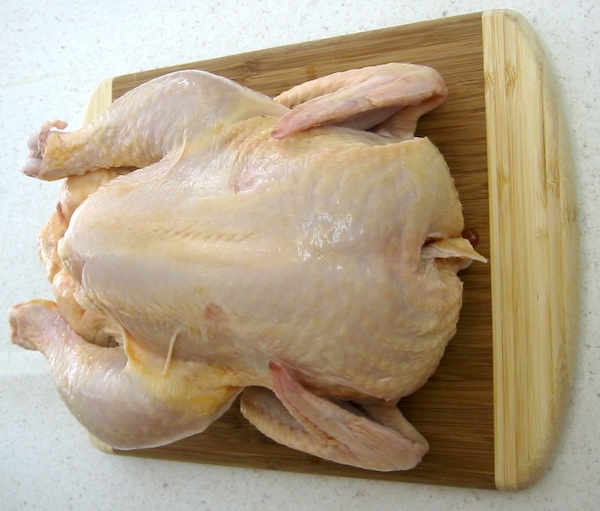
Removing the skin from the torso of the bird is fairly easy. It separates easily from most of the front of the fowl. It is tied down by fine ligaments in only a couple of places, and these ligaments are easily cut. The skin is glued down tightly over the lower spine, but I just cut around that, leaving a patch of skin remaining over the lower spine. I also didn't bother to remove the skin from the wings. My skinned bird looked like this:

Where is the best meat? Where are the biggest muscles? Many people like the breast meat best — the muscles there are the largest on the body, and they are completely free of bones or ligaments or gristle. Why would the muscles be the largest here? These are the flight muscles, the ones responsible for pulling the wings down and keeping the bird in the air. They correspond to the pectoral muscles of people, which perform a similar action on our arms. We don't fly, of course, so our pectoral muscles don't need to be as large.
If you examine any of the muscles closely, you will find fine stripes or lines running through them. Perhaps you've noticed this when you are eating chicken — it tends to pull apart in threads or strips. Perhaps you've noticed that anyone who illustrates muscles draws them with stripes or lines running through them. When you are looking at the pinstripes in the chicken muscle, you are seeing that muscle fabric is made up of threads or fibers. Muscle is fibrous.
You might also notice that not all muscle has exactly the same color. The flight muscles, the muscles that the chicken uses rarely and briefly but that have to be very powerful, are whitish. The legs of the chicken, the parts it uses all day long for posture and walking, are darker. To any ground fowl, the breast muscles are used only for occasional and brief bursts of power, while the legs are used for moderate activity all day long. To a cook or a diner, the breast is “white meat,” and the legs are “dark meat.” Why do you suppose that the “brief burst of power” muscles would be white, and the “endurance muscles” would be closer to the color of blood?
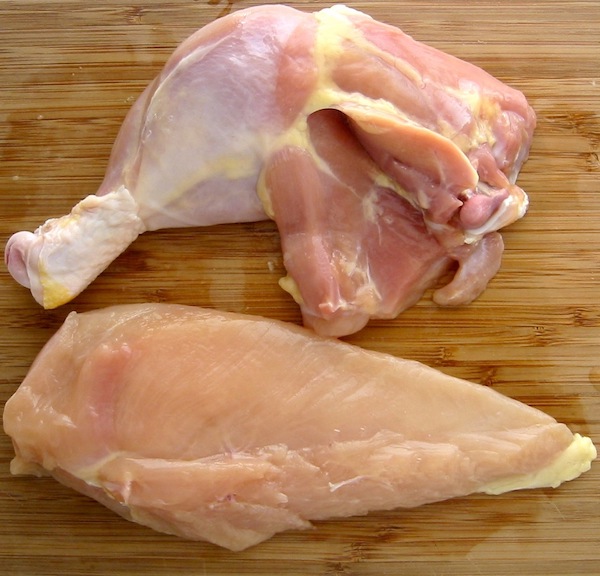
In the middle of a chicken's chest, running down the center, is a ridge of bone that corresponds to the sternum in humans...but with an interesting difference. The exposed outer ridge is only the end of a large “keel” sticking sideways out of the bird's sternum. With the exception of one or two kinds of flightless bird, all birds have a sternum with a keel or carina like this. Bats have them, too. Why? The powerful flight muscles need a strong anchor to grab onto, and this broad, sturdy keel provides that anchor. It is this attachment that you have to sever when you carve the breast meat of a chicken or turkey. If you carefully slice the muscle free from the side of the keel in an uncooked bird, you can discover two layers, corresponding to the pectoralis major and pectoralis minor in people. The pectoralis major flaps the wing down, as you can demonstrate by pulling on it. The pectoralis minor, also known as the supracoracoideus in birds, supposedly gathers into a tendon that runs around the coracoid bone like a pulley, and pulls on the wing from the upper side, causing it to flap up. I tried to demonstrate this by pulling on the pectoralis minor in my chicken, but I couldn't do it without tearing the muscle.
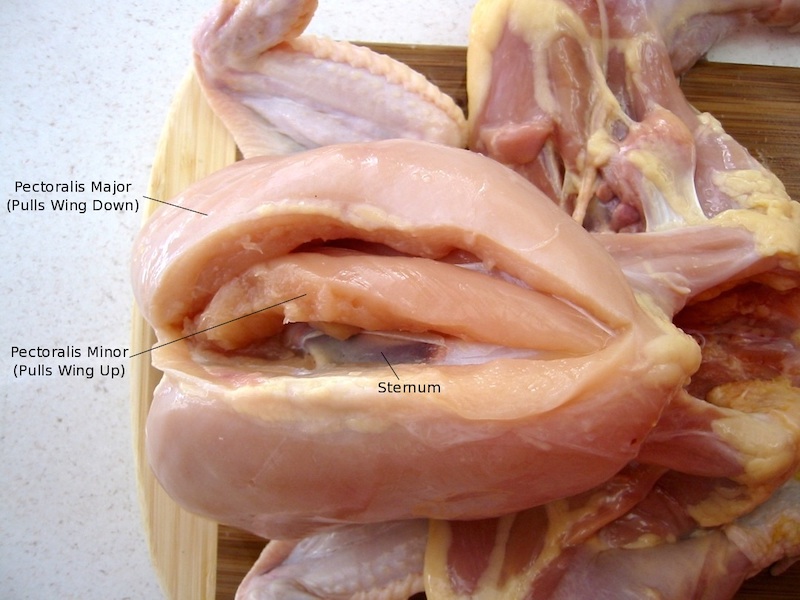
Running among the muscles of the body are fine wires and tiny tubes. These are very tiny, delicate, easy to damage, and hard to find. If you gently and lightly break open the largest joint in a chicken body — the hip joint — and carefully probe within the fold, you may be able to find short sections of these tubes and wires where they are especially large. The wires can be mistaken for tendons, and children will probably identify them as tendons. But they don't come from muscles and they don't attach to bone. The name “nerve” even comes from a Greek word for sinew or tendon...but these non-mechanical wires apparently serve a different function from true tendons. The tubes apparently carry blood — if you nudge the tube you can squish the blood back and forth a little. These are clearly blood vessels. (I have my reasons for suspecting that these are veins, rather than arteries, but I never succeeded in clearly distinguishing them in the chicken.)
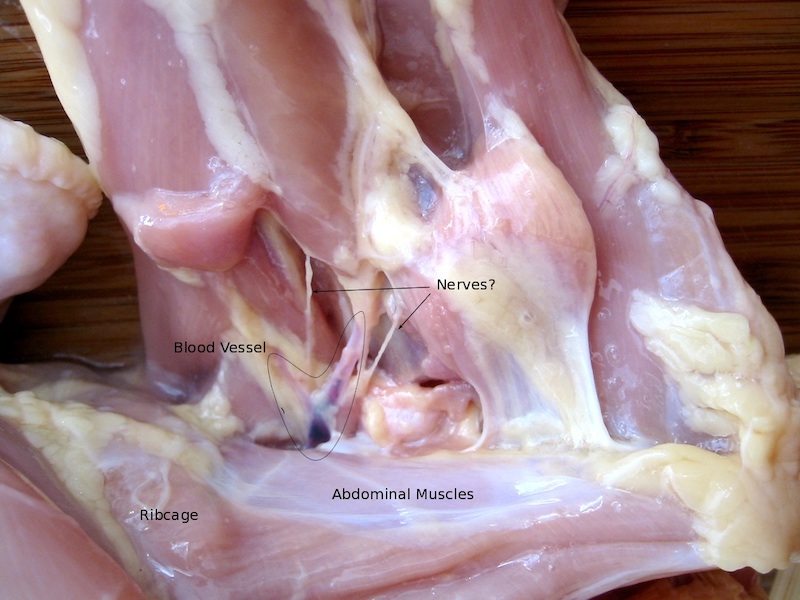
If you can thoroughly clean a chicken without damaging the bones underneath, you will have a nice example of an axial skeleton, or at least a torso skeleton. I broke off the wings and legs, thinking it would be much too tedious to try to clean the entire skeleton, and then I trimmed as much meat from the torso as I could with a knife and scissors. I then boiled the skeleton to soften the remaining meat, after which I could pry or gouge it from the bones with my fingers. This is the result:
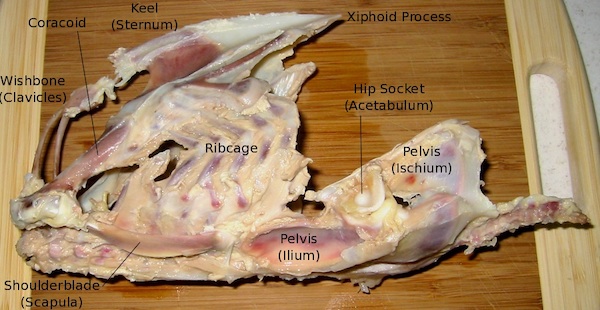
First of all, notice that the overall structure is the same as that of a human: there is a ribcage on top, with some accessory bones where the wings attach, a “waist” in the middle, and a pelvis at the bottom to which the legs attach. One difference between chickens and people is that the “tailbone” in the chicken is actually long enough to make a tail. At the front of the ribcage is a single solid bone resembling, and named after, the human sternum. The difference between a chicken sternum and a human sternum is the gigantic “keel”, the ridge of bone projecting down the center, to which the powerful flight muscles anchor themselves. The sternum ends in a sharp, dagger-like, cartilaginous point. Try feeling the bottom of your own ribcage, and follow the ribs on each side as they rise towards the center and meet at the peak of the thoracic arch, which is also the lower end of the sternum. At this point you may be able to find a similar pointy projection from the bottom of your own sternum. Both chickens and people have a “dagger bone”, although it is very cartilaginous in birds, while it tends to ossify in adult humans. The official name is xiphoid process. (The “xiphoid” comes from the Greek name for a certain short sword which the sternum resembles, and the “process” refers to the fact that it is projecting or proceeding outward.) At the top of the ribcage you can find the wishbone, which corresponds to our own collarbones, or clavicles. The difference between the chicken's wishbone and human clavicles is that in a human, the clavicles are separate bones and are tied by ligaments to the top of the sternum on each side, whereas in the chicken the two clavicles are fused to each other at the ends making a single bone, and the junction is joined to the sternum not directly, but by a flexible elongated ligament. (This ligament joining the wishbone to the sternum is mostly torn in my photo above.) Along the upper back are two flattish bones that correspond to the shoulderblades, or scapulae. There is another large stick-like bone in the bird's shoulder called the coracoid, and there is a portion of a human shoulderblade called the coracoid process. (If a human scapula is a triangle with a claw on top, the coracoid process is one of the prongs of the “claw”.) However, as I understand it, if you trace the skeletal development in embryos, you discover that these two structures originate differently, and therefore do NOT actually correspond. (In technical terms, they are not homologous.) So while the chicken skeleton and the human skeleton share the same overall outline, and we can find example after example of homology in the details of the two skeletons, there are still a few exceptions. Against the backdrop of overall similarity, there are still a handful of minor parts we find in one organism that we don't find in the other.